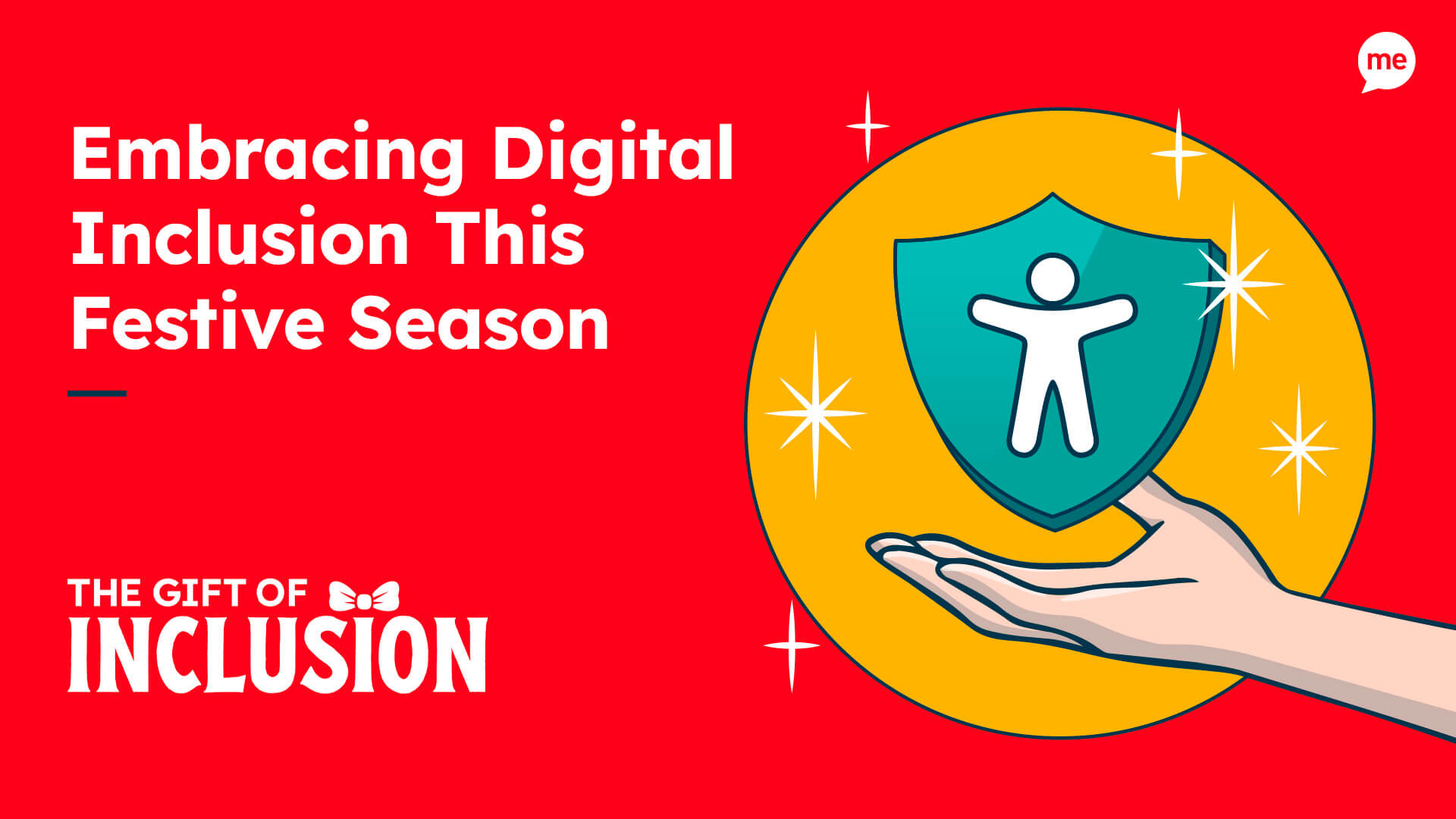Download Free Retail Accessibility Guide
Download NowDiversity and inclusion is an increasingly important issue in the modern world, particularly among consumers. People want to buy products and services from ethical brands and companies that share their values. Therefore, diversity and inclusion should be front and centre of any retail business. Besides being the right thing to do, D&I strategies possess a high return on investment, bringing with them a whole host of, often overlooked, business benefits. This article unpacks these benefits, as well as everything related to ensuring diversity and inclusion within the retail sector.
What is Diversity and Inclusion in Retail?
Diversity in retail refers to the representation of different groups within the workforce, including, but not limited to, people of different race, gender, age, sexual orientation, disability, and cultural background.
Inclusion, on the other hand, is the practice of cultivating a work environment where all employees feel valued, respected, and supported, so that everyone has the tools necessary to participate fully and thrive in their roles. Perhaps a better way to think of it is that diversity brings different backgrounds and perspectives into the mix, while inclusion ensures that these differences are heard by others.
In a retail setting, diversity means having a workforce that mirrors its customer base, which is predominantly achieved through targeted D&I recruitment practices. A supermarket that caters to a multicultural community, for example, would require a multicultural workforce to sufficiently serve its customer base. Specific cultural requirements, like halal meat or kosher products, require people who understand them to help with sourcing, stocking, and selling. After all, it takes a diverse group of people to understand the needs of one.
Inclusion ensures that all employees, once recruited, have equal access to facilities, employee benefits, and other internal opportunities. It is about ousting discrimination from the workplace and providing support for disadvantaged employees in order to level the playing field. This could mean recognising cultural holidays, allowing flexible work arrangements, or creating employee resource groups for different demographics within the company. Whatever the policy, the goal with inclusion is clear – create an environment where every individual can contribute to their fullest potential.
Our 40-page Digital Accessibility & Inclusion Toolkit helps businesses break down online barriers and make a real impact. It offers practical advice on all aspects of digital accessibility, from writing an accessibility statement to accessible website tips and inclusive hiring.

Strategies for Diversity and Inclusion in Retail
Implementing D&I strategies within retail requires a multi-faceted approach. It is not enough to focus solely on recruitment, for example. Diversity and inclusion are two sides of the same coin, and a several pronged attack is needed to both achieve and maintain it. Some of the best practices for diversity and inclusion can be seen below.
Ensure Leadership Commitment
Promoting diversity and inclusion within the retail sector requires a top-down approach. So, before embarking on your D&I renaissance, you must first ratify the commitment of your organisation’s leaders to diversity and inclusion practices. With leadership backing in place, each subsequent D&I strategy becomes much easier to implement.
Once commitment is obtained, whether through written documentation or verbal agreements, it should be espoused throughout the company. Leaders can show their commitment by setting clear D&I goals, allocating resources to D&I initiatives, or holding themselves accountable to the rest of the company.
Implement Diverse Recruitment and Hiring Practices
Diversity in retail, like any sector, stems from the hiring process. There are a number of different hiring practices recruiters can use to make sure they are sourcing their employees from a diverse range of backgrounds.
Firstly, retailers should be using diverse channels to source their employees. This means posting available positions on job boards that are particularly focused on diversity, such as Diverse Jobs, or establishing partnerships with diversity-focused recruitment agencies.
Bias-free hiring, such as blind recruitment, is another hiring practice which seeks to remove discrimination and encourage diversity. Here, personal identifying information in job applications, such as name and nationality, are hidden from the employer so as not to subconsciously influence their decision.

Other methods include the formation of a diverse interview panel, training the recruitment team on how to mitigate unconscious bias, and incorporating inclusive language in job descriptions. You can see all of these different strategies in our inclusive recruitment checklist.
Provide Staff Training and Development
Regular training on diversity and inclusion can help employees understand the importance of these values as well as how to espouse them.
Cultural competency is a type of training that helps staff in the retail sector to interact effectively with a diverse mix of customers and colleagues. It teaches staff about cultural differences and communication styles while helping them overcome preconceived stereotypes or unconscious biases. Very often, this results in better customer service and improved employee relations – a win-win for business.
Build an Accessible Website
Another important strategy for diversity and inclusion is the building of an accessible website. In today’s world, where everything is digital, websites have become the shop front of yesteryear. Without one, you stand at a significant disadvantage to your competitors, especially in the retail sector.

Websites are the means through which prospective customers can browse your products, find out about new offers, and learn about your values as a company. Therefore, in order to attract a diverse set of customers, you need a website that works for them. What does this mean exactly?
An accessible website is one where the information and materials displayed on it can be viewed, read, and understood by everyone. It might involve translating website content into multiple languages, uploading relevant audio files, or displaying text in appropriately sized fonts. Recite Me’s Accessibility Toolbar is one example of how you can do this. Once purchased, it allows website visitors to customise your site in a way that works best for them, whilst ensuring your website is fully compliant.
Still unsure where to start? The Web Content Accessibility Guidelines (WCAG), provided by the Worldwide Web Consortium (W3C), are a great first port of call. Ensure compliance with the WCAG and you will have nothing further to worry about.
Develop a Diverse Supply Chain
Diversity in retail can be extended beyond just your employees and customer base. Think about bringing D&I into your supplier network by engaging with suppliers from diverse backgrounds. Given how much importance the modern consumer places on a company’s ethics and values, extending your diverse practices to your supply chain are likely to resonate with your customers, helping to retain the existing ones while attracting new ones. In addition to bolstering your employer brand, helping to attract the best new talent.
Customer Engagement
Engaging with a diverse customer base and ensuring an inclusive customer experience is crucial both for the local community and for business.
Ensuring marketing materials, such as social media ads, are representative of diverse groups is just one way in which retailers can reach a more diverse audience. They may even centre entire marketing campaigns around specific groups or cultural events, using language and symbols that are culturally significant.
Communication is one aspect of customer engagement that is indispensable. Translating product information or hiring bilingual staff, according to the needs of the community you serve, are two great examples of how to be inclusive with your customer comms.
Inclusive Workplace Policies
Developing and enforcing inclusive workplace policies is one of the best strategies for promoting D&I among staff. A whole host of policies can be implemented to safeguard against harassment based on the protected characteristics, as well as to mitigate pay disparities or simply make life more accommodating for disadvantaged individuals.
Flexible working arrangements could be offered to cater for single parents, access ramps may be installed for disabled members of staff, or significant cultural holidays might be recognised as paid time off. Non-English-speaking customers might even have important product information translated for them so that they better understand the offers available. .

The possibilities are endless when it comes to inclusive workplace policies. All you need is a solid understanding of D&I, a spark of creativity, and the desire to cultivate an inclusive environment.
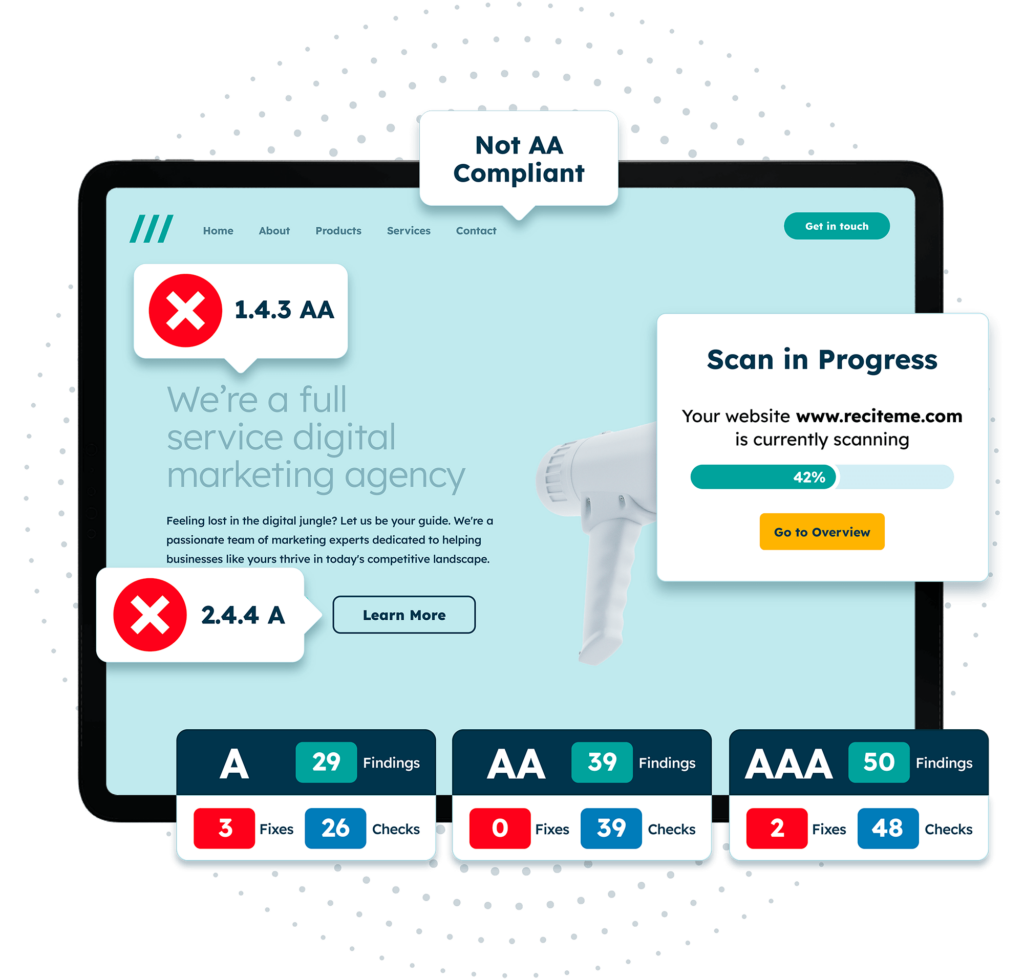
Free Accessibility Check of your Website
Finding accessibility issues is now easier than ever. Recite Me offers a free automated scan of your website’s homepage to highlight non-compliance. You’ll get recommendations on how to fix them, helping to improve your accessibility score.
Benefits of Good Diversity and Inclusion in Retail Organisations
Diversity and inclusion in retail is about more than just being ethical. D&I practices bring with them favourable outcomes for employees, customers, and business alike. Some of the most relevant business benefits for D&I are outlined below:
- Broader Customer Reach: A diverse workforce can better understand and serve a diverse customer base. Having employees who speak multiple languages, for example, can facilitate communications with customers who do not speak English. This allows you to tap into a pool of potential clients that you may not have been able to otherwise.
- Improved Employee Satisfaction: Efforts to make a workplace inclusive are very often met with increased rates of employee satisfaction. This is because staff feel valued and respected. Quite simply, happy employees are more productive and more likely to stay with the company, reducing turnover costs and preventing any knowledge drain.
- Better Financial Performance: Part of having a more productive workforce and a wider customer reach is increased profitability. In this way, a retail company that promotes gender diversity may outperform its competitors because it attracts and retains top talent who then appeal to a wider range of customers, boosting sales in the process.
- Enhanced Innovation and Creativity: People share ideas based on their lived experience, so the more diverse your teams, the more unique ideas you have to choose from. Within the retail sector, this could lead to the development of unique products and services that cater to a broader audience and help drive sales as a result.
- Enhanced Company Reputation: Modern day consumers want to see that their favourite retailers share their own values. Therefore, if a retailer can demonstrate, through a proven track record of policies and initiatives, that they possess a strong commitment to diversity and inclusion, this will resonate with customers, leading to favourable media coverage, customer endorsements, and increased brand loyalty.
- Improved Customer Experience: As a customer base becomes more fairly represented among retail staff, they tend to be better catered for. This is because they now have people who understand them in charge of the products and services they wish to buy, lending itself to happier, more loyal customers.
- Healthier Society: Promoting diversity and inclusion in retail plays a significant role in shaping social norms. It fosters a culture of respect and understanding, while helping to eradicate discrimination at the same time. Although set in the context of retail employment, these values tend to spill out from the nine to five and into family homes or other areas of life, helping set the foundations for a fairer society in general.
How to Measure and Evaluate the Success of D&I Strategies
Without measuring the success of D&I strategies, it is impossible to know what is working and what isn’t. Tracking your progress also helps you achieve your D&I goals by giving you a clear indication of where you are, so that you can orient yourself and figure out what is required to get where you want to be.
Selecting D&I Metrics
With that said, before anything else, you will need to decide on your D&I goals. These should be specific, measurable, achievable, relevant, and time-bound; for example, increasing the representation of women in leadership positions by 25% within the next three years. From this, you should have a better idea of which metrics you wish to track. Using the same example, this would likely require you to track the number of employees from different demographic groups in different positions, as well as things like hiring rates and promotions.
For a more inclusion-based goal, employee retention and turnover rates among different demographic groups should be looked at. These two metrics provide a quick assessment of the effectiveness of your company’s inclusive policies. A high turnover of female staff, for example, is a good indication that you are not doing enough to create an inclusive work environment for them.
Gathering & Measuring Metrics
For some metrics, gathering the data is easy. It is as simple as collating existing information you may have on your employees. Other metrics might require a bit of leg work. This is where various mechanisms, such as inclusion surveys, come in. Inclusion surveys are a way of assessing whether or not employees feel valued, respected, and supported. Customer feedback is another mechanism for collecting data, helping retailers gain insight as to whether or not their D&I initiatives are resonating with their customer base.
Comparing D&I metrics before and after an initiative is launched is a great way to see the progress you have made, but it doesn’t help to know where you stand in the wider market. For this, you need external benchmarks. Regularly compare your D&I performance against industry benchmarks to make sure you are performing well in comparison to your competitors. Obtaining certifications from recognised organisations can also validate the effectiveness of your D&I efforts.
AUS Regulations for Promoting Diversity and Inclusion in Retail
The Fair Work Act 2009
The Fair Work Act 2009 includes provisions to protect employees from discrimination and ensure that they are fairly treated in the workplace. Retailers must comply with these regulations by providing equal opportunities and fair conditions for all employees. Part of this is ensuring that all employees, regardless of their background, receive equal pay for equal work and have access to the same career advancement opportunities as one another.
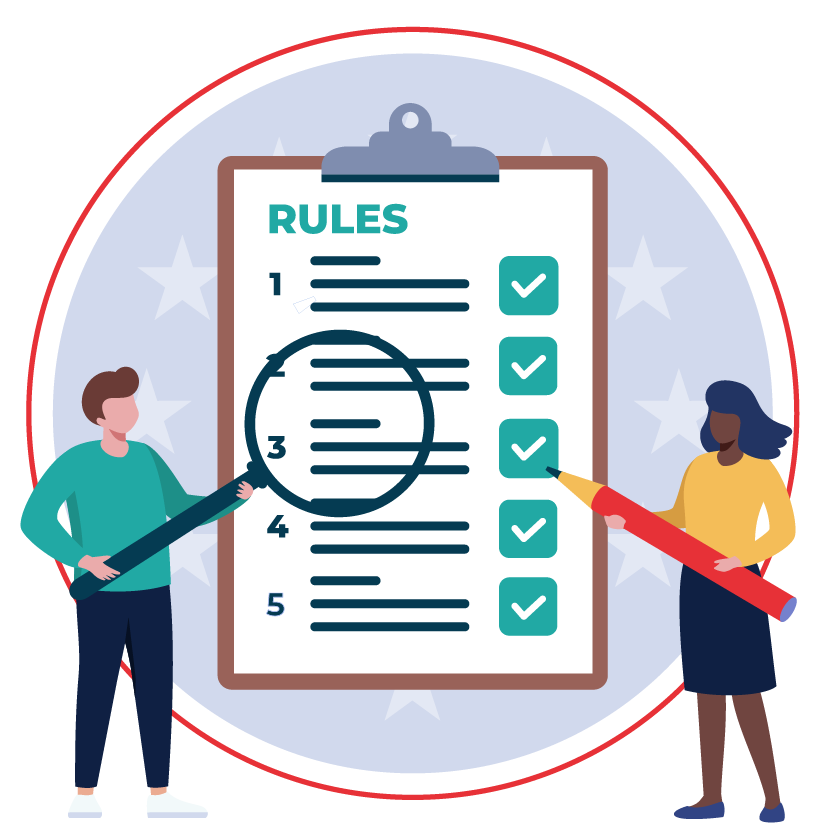
The Racial Discrimination Act 1975
The Racial Discrimination Act 1975 makes it unlawful to discriminate against people on the grounds of race, colour, descent, or national or ethnic origin. As a result, retailers are responsible for ensuring that their practices and policies do not disadvantage customers or employees based on these characteristics. To comply with this, companies might choose to implement training programs aimed at preventing racial bias.
Other similar acts exist across Australian government legislation, such as the Sex Discrimination Act 1984 and the Disability Discrimination Act 1992, each one aimed at addressing a different form of discrimination.
The Workplace Gender Equality Act 2012
The Workplace Gender Equality Act 2012 aims to improve and promote gender equality in working environments. Companies with 100 or more employees must report annually on gender equality indicators, including the gender composition of the workforce and equal remuneration between women and men. If these indicators reflect a disparity, for example in pay, the company is required to address it by implementing appropriate strategies.
Attract the best talent for your organisation by becoming an inclusive employer!
Inclusive recruitment doesn’t have to be complicated. This checklist breaks down everything you need to know to attract and retain diverse candidates. Download your checklist today and get started right away.
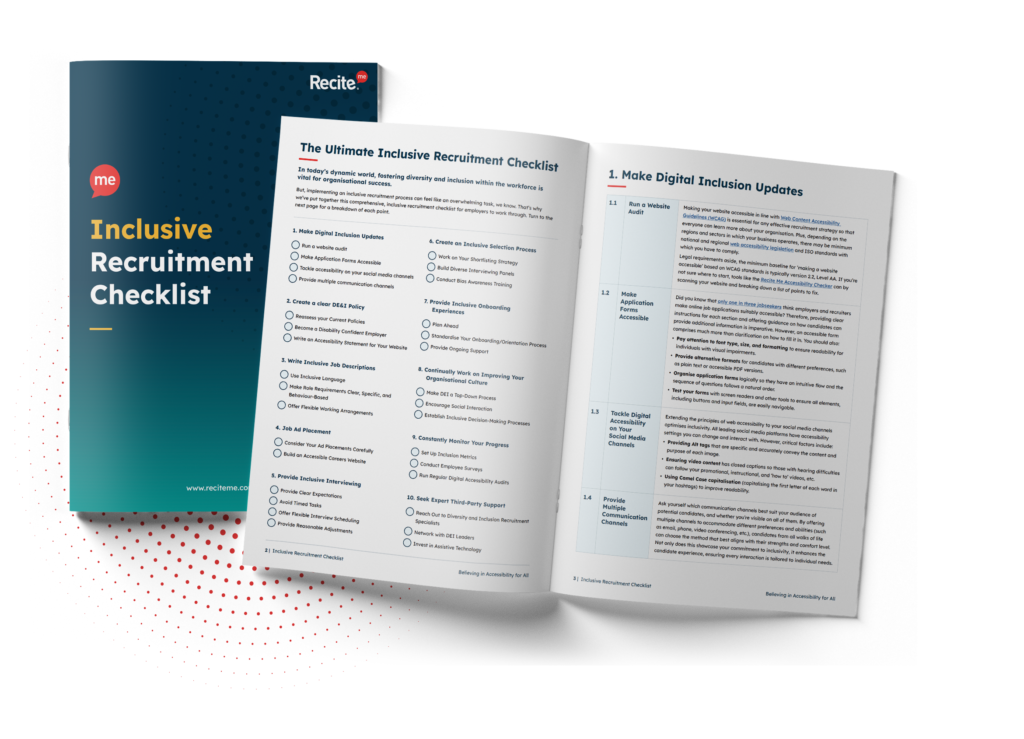
Tools for Improving Diversity and Inclusion in the Retail Sector
At Recite Me we offer a range of accessibility tools to help improve the diversity and inclusion of Retail businesses around the world. We do this through a variety of products including our Accessibility Toolbar and Accessibility Checker, of which more information about them can be seen below.
Accessibility Toolbar
The Recite Me Accessibility Toolbar is a simple software that installs on to your website to help make it more inclusive. This can be important for boosting the D&I standing of your organisation, as it allows users to customise your website in a way that works best for them. Some of the main features include:
- Personalising font size, type, and colour options.
- Choosing the exact colour contrast between the text and background.
- Utilising the mask screen tool to help with focus.
- Using the ruler tool to make reading easier.
- Downloading content as an audio file as an alternative to reading.
- Converting page content into over 100 on-screen languages.
- Having the page read aloud in a choice of 65 languages.
- Customising PDF documents or having them read aloud/ translated.
- Zooming in on any part of a webpage.
- Using the built-in spell-checker and a fully integrated dictionary and thesaurus.

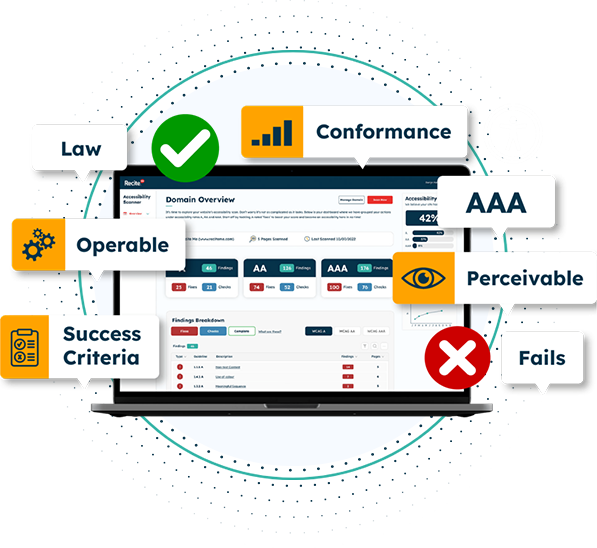
Accessibility Checker
Our Accessibility Checker can help address inaccessibility at its root cause. As the tool performs a complete scan of your website in line with the latest WCAG standards and guidelines. By following a simple four step process to help improve your websites accessibility:
- Step 1: Scan Your Domains – Choose between scanning single or multiple pages.
- Step 2: Identify Accessibility Issues – Identify the locations of accessibility issues on your website.
- Step 3: Fix Accessibility Errors – Boost your accessibility score by prioritising fixes in line with WCAG Levels A, AA, and AAA.
- Step 4: Track Your Progress – Create and share custom reports with your team and roadmap the next issues in your fix queue.

